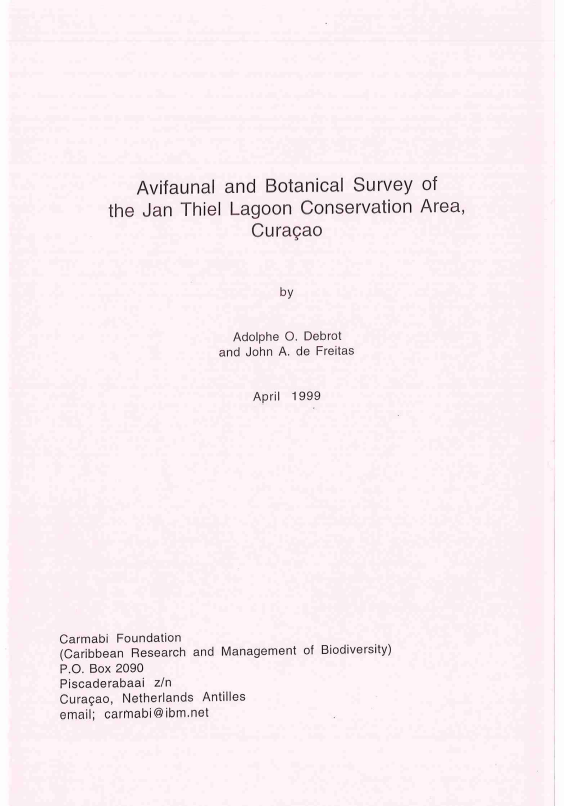Avifaunal and Botanical Survey of The Jan Thiel Lagoon Conservation Area, Curaçao
Submitted by Shassy Cahyani on Thu, 02/25/2021 - 16:53The Jan Thiel lagoon can be considered the most important wetland of Curaçao based on its combined value as a feeding habitat for terns. As is likely the case in general with the other saliñas of Curaçao, Jan Thiel lagoon appears to be of the greatest significance to flamingos during the dry season when the larger wetlands in Venezuela run dry. The lagoon is also an area that has historically provided conditions suitable for massive nesting by rare species of terns. Nesting by terns still occurs but on a much lesser scale and with fewer species. During the rainy season, and because of the presence of many dams which retain fresh water on the eastern half of the lagoon, the area is of persistent value to several waterbirds which showed a preference for feeding in less saline water. These include species such as ducks, sandpipers, and black-winged stilts.
The lagoon is approximately 80 ha and is surrounded by approximately 228 ha of additional scenic conservation area which contain rare tracts of native vegetation and which provide valuable habitat to many other native species such as konènchi, sloke, tapa kaminda, and warawara. The best vegetations are found on the eastern side of the lagoon, particularly the southern quadrant of the eastern half of the lagoon. This quadrant has quite rare vegetation, best described as a Haematoxylon-Coccoloba vegetation in which the dreifi shimaron is found to be abundant on volcanic soil. Such vegetation is also known from areas of Oostpunt, Malpais, and Seru Cocori. Other species remarkably abundant in the Haematoxylon-Coccoloba unit include the mata piska and the palu di pushi while the presence of scattered kibrahacha and mangel di sabana likely indicate species which were once much more abundant but which have somehow survived the intensive use of this area in the past. Rare plant species found in the area include the trees lumbra blanku (Croton niveus), kurahout (Peltophorum acutifolum), mata kombles (Schoepfia schreberi), "fuma machu" (Vitex cymosa). For the latter species, less than 20 trees are known to exist in the Dutch Antilles.
A major limitation to the avifaunal use of the lagoon, particularly the flamingos and tern nesting is the current high level of uncontrolled recreational disturbance. Unintentional recreational disturbance can likely be greatly reduced by a combination of properly informing visitors, by planting vegetation barriers to shelter visitors from the constant sight of the birds and by partially redirecting trails.
The planned Jan Thiel-Amandelweg road is a major threat to the ecological integrity of the conservation area. The road is protected to lie directly in the two most important freshwater areas bordering the lagoon and on top of one of the four locations which support tern breeding. The mere physical presence of the road is in itself a scourge to the vegetation as is cuts through a part of the Haematoxylon-Coccoloba vegetation and lies directly on top of three (fortunately resprouting) very rare Vitex cymosa trees. If this road is ever built it will add a large source of constant disturbance (incl. traffic noise) for much of the eastern half of the lagoon (which is the principal area used by the avifauna), and a major source of littering and contaminants from vehicles.
The abandoned landfill of Koraal Specht has not been sealed to prevent rainwater percolation and several seeps were seen to emanate from the landfill and flow into the lagoon. The landfill likely forms a serious long-term threat to the lagoon and a study is needed with regards to the potential leaching of contaminants.

